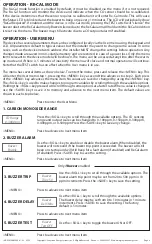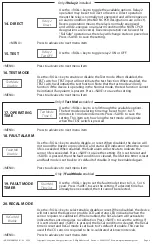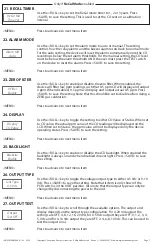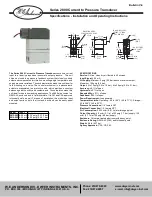
Page 8
Menu
Exit
Press <SAVE> to exit the menu and return to normal operation or <MENU> to
repeat the menu.
28. EXIT
CALIBRATION
The CO transmitter features a cover mounted
sensor PCB that is pre-calibrated. This means
that the entire sensor PCB can simply be
replaced with a new calibrated PCB if desired
without having to remove the enclosure and
the main processor board. This sensor swap
can be completed in seconds. Simply unplug
the device ribbon cable connection, remove
the old sensor PCB, install the new PCB and
reconnect the ribbon cable. There is no need
to make any adjustments or apply gas to the
transmitter using the sensor swap method.
In
this case, the Fault Mode should be reset if it
is enabled.
The device may also be calibrated or verified with the CO gas if required. This requires a field calibration kit
consisting of a bottle of gas (250 ppm CO in air for example), a tank pressure regulator with flow restrictor
and the necessary tubing with a calibration cap to cover to the sensor. Calibration can be done at 20 to
27°C.
Verification with gas can be done without removing the device cover. Simply apply gas using the calibration
cap attached directly to the port on the cover and monitor the output signal or LCD.
The device cover must be opened to perform an actual calibration. In the case, the gas calibration cap
attached to the sensor fixture on the cover as before. The sensor must be continuously powered for at least
1/2 hour prior to calibration. Calibrate the sensor first in clean air with no CO gas present. Simply adjust the
ZERO pot on the sensor board until 4 mA (or 0 Vdc) output is obtained and the LCD displays 0 ppm. Note
that the "0 Filter" menu item should be disabled to set the 0 ppm. The ZERO and SPAN pots are located on
the edge of the cover sensor PCB and are clearly marked on the PCB.
Then attach the gas supply. Turn the regulator on/off knob fully off and attach it to the 250 ppm gas bottle
and firmly tighten it by hand. Moisten the sponge and squeeze out any excess water. Place the sponge in
the cap so that it will not touch the sensor but does not plug the hole in the side of the cap. Attach the cap
to the fixture over the sensor. If the gas cap is too loose on the fixtures, simply place a wrap of electrical
tape around the cap the tighten. Slowly turn the valve knob on the regulator to let the gas begin flowing.
The regulator will restrict the flow rate to the specified 200 ml/min and the sponge will ensure the gas is
in the right humidity range. Wait for 5 minutes and then adjust the SPAN pot on the sensor board until the
output and LCD reads 250 ppm. Close the valve on the tank and take a cap off from the sensor.
Calibration
is complete. In this case, the ReCal Mode should be reset if it is enabled.
DIMENSIONS
Figure 5
IN-GE-CMD5B5XXX-01-02 03/19
Copyright © Greystone Energy Systems, Inc. All Rights Reserved Phone: +1 506 853 3057 Web: www.greystoneenergy.com



























